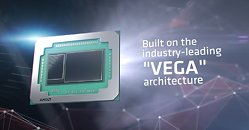Tuesday, October 30th 2018

AMD Radeon Pro Vega Graphics Coming to MacBook Pro Next Month
Today Apple has introduced its new iPad Pro and has resurrected both the MacBook Air, now with Retina display, and the Mac mini. In addition to all these new announcements, there's another one the company didn't talk about at the event: an update for the MacBook Pro that will now feature AMD Radeon Pro Vega graphics chips. According to Apple, this will allow a 60% improvement in performance over the Radeon Pro 560X, the most powerful GPUs available to date for the MacBook Pro.
These professional-oriented chips are manufactured on a 14 nm process, this is not the 7 nanometer Vega 20 that's expected to be released later this year for the enterprise space. The GPU is codenamed "Vega 12" and comes with HBM2 memory, which helps reduce space requirements in a notebook, compared to traditional GDDR5 memory. Vega Pro 20 in the MacBook Pro has 20 CUs (1,280 shaders), Vega Pro 16 has 16 CUs (1,024 shaders). Both MacBook Pro configurations will be available on November 14th at a price yet to be determined.
Source:
Apple
These professional-oriented chips are manufactured on a 14 nm process, this is not the 7 nanometer Vega 20 that's expected to be released later this year for the enterprise space. The GPU is codenamed "Vega 12" and comes with HBM2 memory, which helps reduce space requirements in a notebook, compared to traditional GDDR5 memory. Vega Pro 20 in the MacBook Pro has 20 CUs (1,280 shaders), Vega Pro 16 has 16 CUs (1,024 shaders). Both MacBook Pro configurations will be available on November 14th at a price yet to be determined.



20 Comments on AMD Radeon Pro Vega Graphics Coming to MacBook Pro Next Month
I'm thinking the Radeon Vega Pro 20 with 1280 stream processors in this MBP upgrade has a 30-40 W TDP.
Edit: Oh and the Radeon Vega Pro 20 is probably a 12 nm FinFet process.
This is Vega 20 SKU for consumers which is built on 14nm as it's specified on AMD's website. This was announced/teased as CES 2018.
www.amd.com/en/graphics/radeon-pro-vega-20-pro-vega-16
Then I read the comments... Now it makes sense
ever since then they've just been cramming hotter components in them (6 core gpu, higher wattage AMD gpus) and making the chassis slimmer with less airflow. I imagine these don't perform anywhere near spec.
I really feel sorry for the people that get to learn that after spending a few grand on one of these.
Adding the additional heat of the GPU to that design is irresponsible. I'm curious to see the reviews of the top end model.
That's the score drop off on consecutive tests of cinebench - within 1-2 mins you become heat saturated and lose 10-15% performance - not even pushing that 560x.
Nvm saw this.All laptops drops in performance these days.